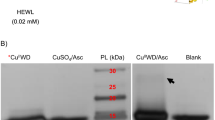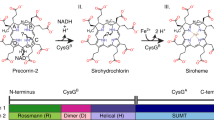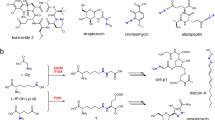Abstract
S-Nitrosothiols are known as reagents for NO storage and transportation and as regulators in many physiological processes. Although the S-nitrosylation catalysed by haem proteins is well known, no direct evidence of S-nitrosylation in copper proteins has been reported. Here, we report reversible insertion of NO into a copper–thiolate bond in an engineered copper centre in Pseudomonas aeruginosa azurin by rational design of the primary coordination sphere and tuning its reduction potential by deleting a hydrogen bond in the secondary coordination sphere. The results not only provide the first direct evidence of S-nitrosylation of Cu(II)-bound cysteine in metalloproteins, but also shed light on the reaction mechanism and structural features responsible for stabilizing the elusive Cu(I)–S(Cys)NO species. The fast, efficient and reversible S-nitrosylation reaction is used to demonstrate its ability to prevent NO inhibition of cytochrome bo3 oxidase activity by competing for NO binding with the native enzyme under physiologically relevant conditions.
This is a preview of subscription content, access via your institution
Access options
Subscribe to this journal
Receive 12 print issues and online access
$259.00 per year
only $21.58 per issue
Buy this article
- Purchase on Springer Link
- Instant access to full article PDF
Prices may be subject to local taxes which are calculated during checkout




Similar content being viewed by others
References
Singel, D. J. & Stamler, J. S. Chemical physiology of blood flow regulation by red blood cells. Annu. Rev. Physiol. 67, 99–145 (2005).
Xu, L., Eu, J. P., Meissner, G. & Stamler, J. S. Activation of the cardiac calcium release channel (ryanodine receptor) by poly-S-nitrosylation. Science 279, 234–237 (1998).
Ozawa, K. et al. S-nitrosylation of β-arrestin regulates β-adrenergic receptor trafficking. Mol. Cell 31, 395–405 (2008).
Benhar, M., Forrester, M. T., Hess, D. T. & Stamler, J. S. Regulated protein denitrosylation by cytosolic and mitochondrial thioredoxins. Science 320, 1050–1054 (2008).
Anand, P. & Stamler, J. S. Enzymatic mechanisms regulating protein S-nitrosylation: implications in health and disease. J. Mol. Med. 90, 233–244 (2012).
Smith, B. C. & Marletta, M. A. Mechanisms of S-nitrosothiol formation and selectivity in nitric oxide signaling. Curr. Opin. Chem. Biol. 16, 498–506 (2012).
Bosworth, C. A., Toledo, J. C., Zmijewski, J. W., Li, Q. & Lancaster, J. R. Dinitrosyliron complexes and the mechanism(s) of cellular protein nitrosothiol formation from nitric oxide. Proc. Natl Acad. Sci. USA 106, 4671–4676 (2009).
Gow, A. J., Luchsinger, B. P., Pawloski, J. R., Singel, D. J. & Stamler, J. S. The oxyhemoglobin reaction of nitric oxide. Proc. Natl Acad. Sci. USA 96, 9027–9032 (1999).
Herold, S. & Röck, G. Reactions of deoxy-, oxy-, and methemoglobin with nitrogen monoxide: mechanistic studies of the S-nitrosothiol formation under different mixing conditions. J. Biol. Chem. 278, 6623–6634 (2003).
Chan, N.-L., Kavanaugh, J. S., Rogers, P. H. & Arnone, A. Crystallographic analysis of the interaction of nitric oxide with quaternary-T human hemoglobin. Biochemistry 43, 118–132 (2004).
Weichsel, A. et al. Heme-assisted S-nitrosation of a proximal thiolate in a nitric oxide transport protein. Proc. Natl Acad. Sci. USA 102, 594–599 (2005).
Schreiter, E. R., Rodríguez, M. M., Weichsel, A., Montfort, W. R. & Bonaventura, J. S-nitrosylation-induced conformational change in blackfin tuna myoglobin. J. Biol. Chem. 282, 19773–19780 (2007).
Romeo, A. A., Capobianco, J. A. & English, A. M. Superoxide dismutase targets NO from GSNO to Cysβ93 of oxyhemoglobin in concentrated but not dilute solutions of the protein. J. Am. Chem. Soc. 125, 14370–14378 (2003).
Mani, K., Cheng, F., Havsmark, B., David, S. & Fransson, L.-Å. Involvement of glycosylphosphatidylinositol-linked ceruloplasmin in the copper/zinc-nitric oxide-dependent degradation of glypican-1 heparan sulfate in rat C6 glioma cells. J. Biol. Chem. 279, 12918–12923 (2004).
Inoue, K. et al. Nitrosothiol formation catalyzed by ceruloplasmin: implication for cytoprotective mechanism in vivo. J. Biol. Chem. 274, 27069–27075 (1999).
Shiva, S. et al. Ceruloplasmin is a NO oxidase and nitrite synthase that determines endocrine NO homeostasis. Nature Chem. Biol. 2, 486–493 (2006).
Stubauer, G., Giuffrè, A. & Sarti, P. Mechanism of S-nitrosothiol formation and degradation mediated by copper ions. J. Biol. Chem. 274, 28128–28133 (1999).
Bertini, I., Cavallaro, G. & McGreevy, K. S. Cellular copper management—a draft user's guide. Coord. Chem. Rev. 254, 506–524 (2010).
Williams, D. L. H. The mechanism of nitric oxide formation from S-nitrosothiols (thionitrites). Chem. Commun. 1085–1091 (1996).
Williams, D. L. H. The chemistry of S-nitrosothiols. Acc. Chem. Res. 32, 869–876 (1999).
Wever, R., Van Leeuwen, F. X. R. & Van Gelder, B. F. The reaction of nitric oxide with ceruloplasmin. Biochim. Biophys. Acta 302, 236–239 (1973).
van Leeuwen, F. X. R., Wever, R., van Gelder, B. F., Avigliano, L. & Mondovi, B. The interaction of nitric oxide with ascorbate oxidase. Biochim. Biophys. Acta 403, 285–291 (1975).
Gorren, A. C. F., de Boer, E. & Wever, R. The reaction of nitric oxide with copper proteins and the photodissociation of copper–NO complexes. Biochim. Biophys. Acta 916, 38–47 (1987).
Ehrenstein, D., Filiaci, M., Scharf, B., Engelhard, M. & Nienhaus, G. U. Ligand binding and protein dynamics in cupredoxins. Biochemistry 34, 12170–12177 (1995).
Hall, C. N. & Garthwaite, J. What is the real physiological NO concentration in vivo? Nitric Oxide 21, 92–103 (2009).
Lancaster, K. M., DeBeer George, S., Yokoyama, K., Richards, J. H. & Gray, H. B. Type-zero copper proteins. Nature Chem. 1, 711–715 (2009).
Lancaster, K. M. et al. Outer-sphere contributions to the electronic structure of type zero copper proteins. J. Am. Chem. Soc. 134, 8241–8253 (2012).
Sieracki, N. A. et al. Copper–sulfenate complex from oxidation of a cavity mutant of Pseudomonas aeruginosa azurin. Proc. Natl Acad. Sci. USA 111, 924–929 (2014).
Wilson, T. D., Yu, Y. & Lu, Y. Understanding copper-thiolate containing electron transfer centers by incorporation of unnatural amino acids and the CuA center into the type 1 copper protein azurin. Coord. Chem. Rev. 257, 260–276 (2013).
Liu, J. et al. Redesigning the blue copper azurin into a redox-active mononuclear nonheme iron protein: preparation and study of Fe(II)-M121E azurin. J. Am. Chem. Soc. 136, 12337–12344 (2014).
Arciero, D. M., Pierce, B. S., Hendrich, M. P. & Hooper, A. B. Nitrosocyanin, a red cupredoxin-like protein from Nitrosomonas europaea. Biochemistry 41, 1703–1709 (2002).
Chain, P. et al. Complete genome sequence of the ammonia-oxidizing bacterium and obligate chemolithoautotroph Nitrosomonas europaea. J. Bacteriol. 185, 2759–2773 (2003).
Schmidt, I., Steenbakkers, P. J. M., op den Camp, H. J. M., Schmidt, K. & Jetten, M. S. M. Physiologic and proteomic evidence for a role of nitric oxide in biofilm formation by Nitrosomonas europaea and other ammonia oxidizers. J. Bacteriol. 186, 2781–2788 (2004).
Basumallick, L. et al. Spectroscopic and density functional studies of the red copper site in nitrosocyanin: role of the protein in determining active site geometric and electronic structure. J. Am. Chem. Soc. 127, 3531–3544 (2005).
Holm, L. & Rosenström, P. Dali server: conservation mapping in 3D. Nucleic Acids Res. 38, 545–549 (2010).
Gray, H. B., Malmström, B. G. & Williams, R. J. Copper coordination in blue proteins. J. Biol. Inorg. Chem. 5, 551–559 (2000).
Lieberman, R. L., Arciero, D. M., Hooper, A. B. & Rosenzweig, A. C. Crystal structure of a novel red copper protein from Nitrosomonas europaea. Biochemistry 40, 5674–5681 (2001).
Messerschmidt, A. et al. Rack-induced metal binding vs. flexibility: Met121His azurin crystal structures at different pH. Proc. Natl Acad. Sci. USA 95, 3443–3448 (1998).
Pascher, T., Karlsson, B. G., Nordling, M., Malmström, B. G. & Vänngård, T. Reduction potentials and their pH dependence in site-directed-mutant forms of azurin from Pseudomonas aeruginosa. Eur. J. Biochem. 212, 289–296 (1993).
Marshall, N. M. et al. Rationally tuning the reduction potential of a single cupredoxin beyond the natural range. Nature 462, 113–116 (2009).
Hosseinzadeh, P. et al. Design of a single protein that spans the entire 2-V range of physiological redox potentials. Proc. Natl Acad. Sci. USA 113, 262–267 (2016).
Yanagisawa, S., Banfield, M. J. & Dennison, C. The role of hydrogen bonding at the active site of a cupredoxin: the Phe114Pro azurin variant. Biochemistry 45, 8812–8822 (2006).
Lu, Y. in Comprehensive Coordination Chemistry II (eds McCleverty, J. A. & Meyer, T. J.) 91–122 (Pergamon, 2003).
Keefer, L. K., Nims, R. W., Davies, K. M. & Wink, D. A. in Methods in Enzymology Vol. 268 (ed. Lester, P.) 281–293 (Academic, 1996).
Solomon, E. I. Spectroscopic methods in bioinorganic chemistry: blue to green to red copper sites. Inorg. Chem. 45, 8012–8025 (2006).
Sarti, P. et al. Nitric oxide and cytochrome c oxidase: mechanisms of inhibition and NO degradation. Biochem. Biophys. Res. Commun. 274, 183–187 (2000).
Jourd'heuil, D., Laroux, F. S., Miles, A. M., Wink, D. A. & Grisham, M. B. Effect of superoxide dismutase on the stability of S-nitrosothiols. Arch. Biochem. Biophys. 361, 323–330 (1999).
Zhang, S., Çelebi-Ölçüm, N., Melzer, M. M., Houk, K. N. & Warren, T. H. Copper(I) nitrosyls from reaction of copper(II) thiolates with S-nitrosothiols: mechanism of NO release from RSNOs at Cu. J. Am. Chem. Soc. 135, 16746–16749 (2013).
Oh, B. K. & Meyerhoff, M. E. Spontaneous catalytic generation of nitric oxide from S-nitrosothiols at the surface of polymer films doped with lipophilic copper(II) complex. J. Am. Chem. Soc. 125, 9552–9553 (2003).
Toubin, C., Yeung, D. Y. H., English, A. M. & Peslherbe, G. H. Theoretical evidence that CuI complexation promotes degradation of S-nitrosothiols. J. Am. Chem. Soc. 124, 14816–14817 (2002).
Baciu, C., Cho, K.-B. & Gauld, J. W. Influence of Cu+ on the RS−NO bond dissociation energy of S-nitrosothiols. J. Phys. Chem. B 109, 1334–1336 (2005).
Wang, P. G. et al. Nitric oxide donors: chemical activities and biological applications. Chem. Rev. 102, 1091–1134 (2002).
Acknowledgements
This material is based on work supported by the US National Science Foundation (award no. CHE 14-13328 to Y.L.) and the National Institutes of Health (NIH award no. DK31450 to E.I.S. and award no. GM054803 to N.J.B.). The authors thank H. Matsumura and P. Moënne-Loccoz for performing an initial investigation using resonance Raman spectroscopy, Z. Ding for providing E. coli cytochrome bo3 oxidase and K. Hwang for discussions and revisions of the manuscript. Use of the Stanford Synchrotron Radiation Lightsource, SLAC National Accelerator Laboratory, is supported by the US Department of Energy, Office of Science, Office of Basic Energy Sciences (contract no. DE-AC02-76SF00515). The SSRL Structural Molecular Biology Program is supported by the DOE Office of Biological and Environmental Research and by the NIH and the National Institute of General Medical Sciences (NIGMS, including P41GM103393). The contents of this publication are solely the responsibility of the authors and do not necessarily represent the official views of NIGMS or NIH.
Author information
Authors and Affiliations
Contributions
S.T., J.L., N.M.M. and Y.L. conceived and designed the experiments. S.T., J.L., P.H., Y.Y. and H.R. performed the experiments. S.T., R.E.C., P.H., M.J.N., N.J.B., E.I.S. and Y.L. analysed the data. S.T., J.L., R.E.C., E.I.S. and Y.L. co-wrote the paper. All authors discussed the results and commented on the manuscript.
Corresponding authors
Ethics declarations
Competing interests
The authors declare no competing financial interests.
Supplementary information
Supplementary information
Supplementary information (PDF 4044 kb)
Rights and permissions
About this article
Cite this article
Tian, S., Liu, J., Cowley, R. et al. Reversible S-nitrosylation in an engineered azurin. Nature Chem 8, 670–677 (2016). https://doi.org/10.1038/nchem.2489
Received:
Accepted:
Published:
Issue Date:
DOI: https://doi.org/10.1038/nchem.2489
This article is cited by
-
A switch for blue copper proteins?
Nature Chemistry (2016)



